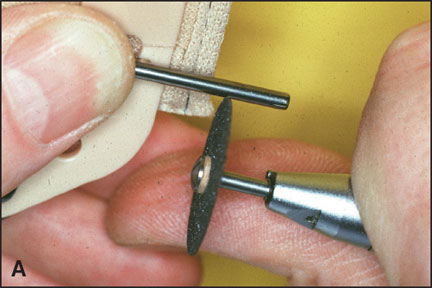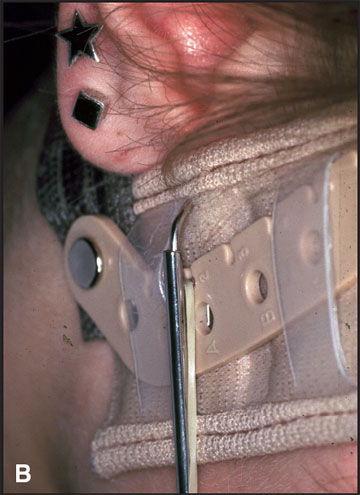Regarding the "Pearl" on "J-Hook Headgear Safety" by Dr. S. Everett Rushing (JCO, October 2006): Like Dr. Rushing, I like J-hook headgears because Jack Hickham was one of the finest orthodontists I ever met. I know for a fact that Jack took safety concerns very seriously from the beginning. That is why he established his J-hook "rule of thumb": The distance between the sliding tube and the cleat on the J-hook should not exceed the thickness of your thumb.
This is a simple matter in almost any patient, because the headstraps allow considerable adjustment. Problems can arise, however, in patients with extremely small or large heads (or overly fluffy hair styles). For a small head, one can shorten the sliding tube (Fig. A). For a large head, I simply grind off the cleat and spot-weld a new one to the J-hook, a thumb's width away from the sliding tube. Spot-welding also works in the first situation, instead of cutting the sliding tube.
To prevent the patient from pulling the J-hook with the elastic out of the sliding tube and letting it snap back, which could cause serious injury, I shorten the distal end of the J-hook and bend over the remaining end (Fig. B). Following Jack Hickham's safety instructions, I have never had any problems in all the decades I have used J-hook headgears--except for a few parents complaining about torn pillows. In such a case, after advising them to buy better-quality pillowcases, I slip a piece of plastic tubing over the cleat on the J-hook.
REGINALD MIETHKE, DDS, PHD
President, European Orthodontic Society
Chairman, Institute of Orthodontics,
Dentofacial Orthopedics, and Pedodontics
CharitéCentrum for Dentistry
Charité - Universitätsmedizin Berlin
Campus Virchow-Klinikum
Augustenburger Platz 1
13353 Berlin
Germany
rainer-r.miethke@charite.de



